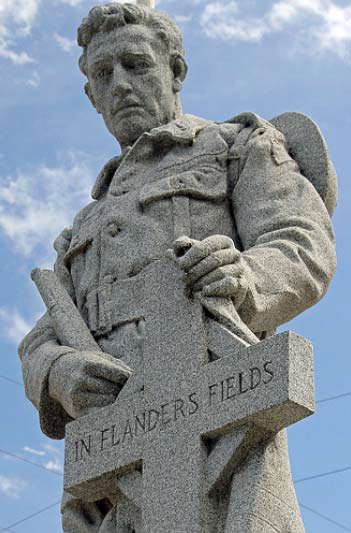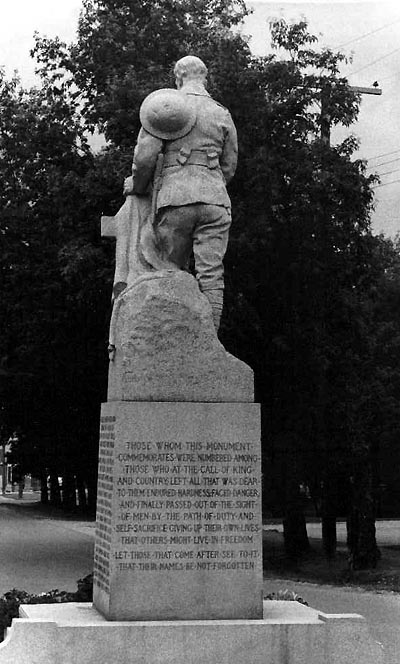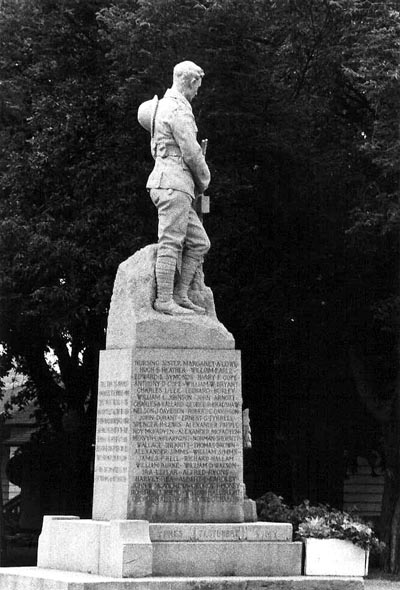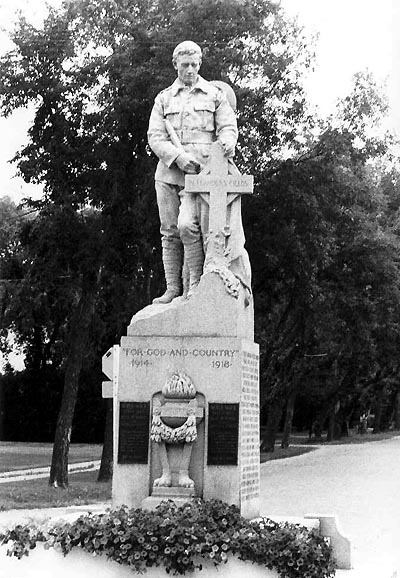The Russell Cenotaph was unveiled at a ceremony on June 22, 1922, in the presence of approximately 2,000 people from the surrounding district. It was erected by local Veterans in memory of the 83 men from the Town of Russell, Village of Binscarth and the Rural Municipalities of Boulton, Russell, Silver Creek and Shellmouth, who laid down their lives in the Great War.
Emanuel Hahn's design represents the sorrows caused by war. The soldier atop the cenotaph looks down in sadness at the ground below him, as if he might find there, his fallen comrades, if not for the tragedy of war. The statue depicts a young, grieving Canadian soldier in First World War army uniform. With uncovered head, he is standing at a battlefield grave – a simple cross with poppies and a broken chain at the base and the flag draped behind it – the final resting place of a comrade killed in action. His left hand rests on the cross, while his right hand holds a reversed rifle. His helmet is slung over his shoulder.
Plaques commemorating the Second World War dead were added on November 11, 1980, as a result of a donation by the Ladies Auxiliary of the Royal Canadian Legion Branch No. 159. In 1999, the head of the soldier atop the memorial was removed by vandals. It was later recovered and reattached. The monument was refurbished in 2000 as a project of the 677 Russell Royal Canadian Air Cadets and funded by a Millennium grant from the Department of National Defence. Additional donations were provided by the Royal Canadian Legion Branch No. 159, Pelly Trail Metis Federation, Town of Russell, and several individuals.
Emanuel Hahn moved to Toronto at the age of seven with his family of artists and musicians from Germany, in 1888. He studied commercial design and model-making at Toronto Technical School and Ontario College of Art and Industrial Design. At 25 years old Hahn began a nearly lifelong contract with Thomson Monument Company of Toronto. Two years later, he also started work as a studio assistant to sculptor Walter Seymour Allward. Part of his duties included assisting on Allward’s significant works such as the South African War Memorial in Toronto.
In 1912 Hahn began an association with the Thomson Monument Company of Toronto. It was there, along with several assistants, he made the many war memorials that are found across Canada: Fernie, British Columbia; Killarney and Russell, Manitoba; Alvinston, Bolton, Cornwall, Hanover, Lindsay, Malvern, Milton, Petrolia and Port Dalhousie, Ontario; Gaspe, Quebec; Moncton, New Brunswick; Springhill and Westville Nova Scotia; Summerside, Prince Edward Island.
Hahn is probably most famous as the designer of the Bluenose on the back of the Canadian dime and the Caribou on the back of the Canadian quarter. He was a victim of anti-German sentiment in the years following the Great War, when his design for the Winnipeg Cenotaph was rejected in 1925.



